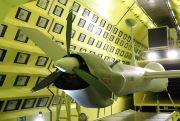The aviation industry also depends on climatic wind tunnels to test new products under extreme environmental conditions, since “in-situ” examinations are time-consuming, difficult to reproduce and even dangerous in many cases.
 Typical tests in the Icing-Wind-Tunnel are the following:
Typical tests in the Icing-Wind-Tunnel are the following:
(For more details have a look at the aviation brochure under "Downloads" on the right)
|
 Atmospheric icing conditions must be created according to the relevant standards for simulating a flight through super-cooled clouds. This requires the liquid water content of the air to be ensured for a specific droplet distribution and at various wind speeds (see Spraytec droplet measuring instrument), which can be done online using state-of-the-art measuring methods. The pressure losses at the turbine engine intake caused by icing and changes in air throughput are measured and documented.
Atmospheric icing conditions must be created according to the relevant standards for simulating a flight through super-cooled clouds. This requires the liquid water content of the air to be ensured for a specific droplet distribution and at various wind speeds (see Spraytec droplet measuring instrument), which can be done online using state-of-the-art measuring methods. The pressure losses at the turbine engine intake caused by icing and changes in air throughput are measured and documented.
The so-called “ice-shedding effect“ occurs when the helicopter gets into icing conditions and the pilot must descend into warmer air as quickly as possible. The rapid warming may cause ice accretions to be released and drawn into the turbine intakes where they may cause severe defects and damage. Condensation in the fuel tank may result in the formation of ice droplets during long flights at low temperatures. This may cause the fuel filter to clog but must not result in stalling of the engines.
More detailed information see: available simulation methods in the Icing Wind Tunnel




